The Aerogel Advantage: Enhanced Insulation
|
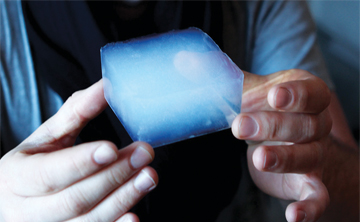
|
| With a thermal conductivity down to 13 mW/(mK) for commercial products they show remarkable characteristics compared to traditional thermal insulation materials. |
Among the environmental issues in today's world, none is as present as the Greenhouse gases (GHGs) emissions. Greenhouse gases (GHGs) emissions present a big current issue in developed countries and in many nations. One of the most cost-effective actions for greenhouse gas abatement is to improve the residential and commercial buildings insulation. It is obvious that in order to have a better insulation in buildings, traditional insulation can be used in thicker or multiple layers. Nevertheless, new materials with better thermal properties, such as aerogels and vacuum insulated panels, are being investigated for buildings applications. The aim of rendering buildings sustainable can be achieved only by the production of new advanced materials, and by using them, especially at the glass surfaces, for more resistant envelopes at different external actions which may increase considerably the durability period of a building and may increase the energy efficiency through a high level thermal insulation.
Aerogels are regarded as one of the most promising high performance thermal insulation materials for building applications today. With a thermal conductivity down to 13 mW/(m K) for commercial products they show remarkable characteristics compared to traditional thermal insulation materials. Also the possibility of high transmittances in the solar spectrum is of high interest for the construction sector. With the proper knowledge they give both the architect and engineer the opportunity of re-inventing architectural solutions. Within this work, a review is given on the knowledge of aerogel insulation in general and for building applications in particular. Aerogel is a synthetic porous ultra light material derived from a gel, in which the liquid component of the gel has been replaced with a gas. It is an advanced material which holds 15 entries in the Guinness Book of Records for properties such as lowest density solid and best insulator. It is a silica-based substance, consisting of a loose network of the atom silicon.
Aerogels are nanoporous solids invented in the 1930's - Aerogels are created when silica is gelled in a solvent. When the solvent is removed, what remains is "puffed-up sand", with up to 99% porosity.
Nanopores cage the air molecules, retarding heat flow and long molecular chains increase the solid path-length through the silica, reducing thermal conductivity. These twin innovations helped move aerogels from lab curiosity to industrial product. The supercritical CO2 extraction reduces cycle times from months to hours and casting the wet gel into a fibrous batting provides mechanical integrity.
Aerogel in Flexible Blanket Form
The aerogel blanket is a new material that has very low thermal conductivity that makes the material a good candidate for insulating of walls. In fact, nowadays aerogel blankets are used to improve the energy performance of the existing walls. Using aerogel blankets as insulation material in a wall means replacement of existing insulation material. When a material in a building component is replaced in order to improve a specific performance, it is important to verify the influence of the other functional requirement of the wall such as fire performance.
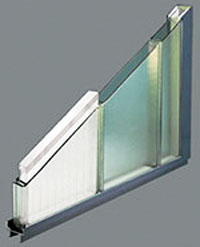 |
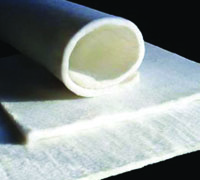 |
Aerogels are synthetic low-density materials with unique physical properties. They are formed by removing the liquid from a gel under special drying conditions, bypassing the shrinkage and cracking experienced during ambient evaporation. This creates a solid three-dimensional nanoporous structure containing 80-99% air. Due to their high porosity, aerogels exhibit the lowest thermal conductivity of any solid, whilst being transparent to light and solar radiation. Aerogels are often cited as a promising material for translucent insulation applications. They can be made from practically any material, although the most common form is silica aerogel which can be produced as granules or in solid (monolithic) tiles. General commercial products for the building sector include:
- Cavity insulation
- Glazing units and cladding systems containing granular aeroge
|
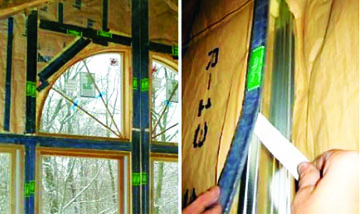
|
| The supercritical CO2 extraction reduces cycle times from months to hours and casting the wet gel into a fibrous batting provides mechanical integrity. |
Translucent and opaque insulation boards, blankets and tensile roof membranes are embedded with aerogel particles. Transparent monolithic silica aerogel has been cited as the 'holy grail' of future glazing technology, with the potential to achieve U-values as low as 0.1 W/m2.K. However, research and development into monolithic glazing is limited due to the high cost of production, long processing time and the difficulty of creating large uniform samples with complete transparency.
Performance of Aerogel
The total thermal conductivity of porous insulation depends on the heat transfer through convection in the pores, conduction through the solid and pores, and radiation. Typically, pores within conventional insulation are over 1mm wide, allowing gas molecules to move freely and transfer thermal energy by convection. By comparison, pores within aerogel can be as small as 20-40nm (even smaller than the 'mean free path' of air at 60-100nm). As a result, individual air molecules within the pores have no space to transfer thermal energy by convection.
Conduction through the solid structure and air molecules within aerogel is also minimal. With little space for convection, air molecules constantly collide with the walls of the pores, suppressing gas conduction. Furthermore, as aerogel only contains 0.1-5% silica and the thermal conductivity of air is very low, heat transfer is minimal and conduction in the gas will diminish with any decreases in pressure. A vacuum inside the pores results in the best insulating properties, with thermal conductivity of 0.004W/m.K (ten times better than conventional insulation).
The amount of radiative heat transfer through aerogel is dependent on the intensity and wavelength of the thermal radiation, the optical properties of the material, the size and shape of its pores and its overall thickness. At ambient temperature,
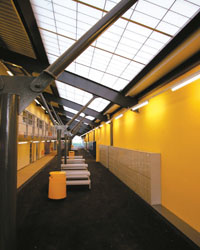 |
the nanosized pores and particles provide effective attenuation of infrared thermal radiation due to high levels of absorption and reflection. The optical and infrared properties of silica aerogels have been well studied. Silica aerogels can be considered transparent insulation materials that effectively transmit solar light, but block thermal infrared radiation.
The material exhibits high translucency, often accompanied by a slight bluish haze. This can be attributed to 'Rayleigh scattering', an optical phenomenon that occurs when light scatters off particles smaller than the wavelength of light, where shorter wavelengths in the blue spectrum are most easily scattered.
|
Environmental impact
To make aerogel involves three key steps: gel preparation, ageing and drying. The aim is to create a gel, strengthen and purify it, then remove all liquid from the pores without collapsing the solid structure (achieved through super-critical or sub-critical drying techniques). These processes typically involve mixing reasonably toxic chemicals and undertaking complex diffusion controlled processes that consume a lot of solvent. Furthermore, the final step is often accompanied by intensive drying processes which may consume large amounts of energy and CO2.
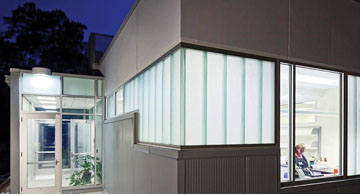 |
Despite this, in 2008, the two major manufactures of silica aerogel both received 'Silver' cradle-to-cradle environmental awards from McDonough Braungart Design Chemistry (MBDC) for their aerogel production. MBDC claim to evaluate a products complete formulation, energy use, water use and recycling potential when assessing environmental impacts. However, the data from these studies is confidential, making it difficult to assess the rigour and validity of the results.
To investigate these issues further, Mark Dowson conducted a firsthand life cycle assessment (LCA) of silica aerogel following ISO standards. Working in collaboration with the University of Bath (who manufacture aerogel as part of an optics research programme) Mark made some aerogel himself, and measured the raw material and electricity use across the production line.
The findings from the study demonstrated how the energy and CO2 required to manufacture high performance silica aerogel insulation can be recovered within 0-2 years (when comparing results to the in-use savings arising from retrofitting to single glazing). Key factors influencing the environmental payback were the efficiency of production and re-use / recycling of materials such as liquid CO2 and solvents.
Health and Safety Aspects of Aerogels
Aerogels are non-crystalline silica with 97% of particles larger than 45µm
- Only the pores are nano-scale (~0.01µm)
- Aerogel particles are much larger
- Demonstrated lack of toxicity, mutagenicity
- Is not expected to pose a carcinogenic risk
- Silicas are inert when ingested, and unlikely to be absorbed through the skin
- No concerns for human health
Three technologies have been developed, with promising initial results:
- Retrofitting polycarbonate panels filled with aerogel granules to existing windows to improve their thermal performance.
- Retrofitting a translucent aerogel panel to the outside of a concrete wall to trap solar energy that can be used to passively warm a building.
- An aerogel solar collector incorporating a translucent polycarbonate cover filled with granular aerogel insulation.
Scores of Advantages
The unique properties of aerogels offer many new applications in buildings. The extraordinary low thermal insulation and optical transparency of aerogels allow its applications in window panes and solar collector covers. Due to their low thermal conductivity and acoustic property for noise abatement, aerogels could be used in buildings, as well as for adsorption and catalysis in indoor air purification, photocatalysis in environmental clean-up, noncombustibility (inorganic aerogels) in fire retardation boards in kitchens. Aerogel materials may also be applied to a building's walls, attics, grounds and appliances. The unusual properties of aerogels open the way to a new range of opportunities for their application in buildings. Their main benefits include excellent insulating properties provide energy and cost savings due to reduced loss of heated or conditioned indoor air, healthier indoor environment due to removal of airborne contaminants, heat- and sound-retarding properties due to the non-combustibility and acoustic properties of the aerogel. Above all they are user-friendly, recyclable and reusable.
Use of Aerogel for Sustainable Building Construction.
Roof: Aerogel insulation can insulate roof cavities or be used to reduce thermal bridging in roof rafters. It can be used for highly insulated homes that are sealed from the outside, both over masonry and under shingles and it has high insulatin value.
Framing: In a typical building, the framing (25% of the building envelope) is un-insulated, resulting in heat loss through the studs. The insulation stops this "thermal bridging" and improves thermal performance up to 40% in steel studs and up to 15% in wood studs.
Floor: Aerogel insulation's thermal efficiency, good compression strength, and thin profile make it attractive as an under floor insulating layer where height is an issue. It installs fast in under floor applications without disrupting door fittings, while providing substantial energy savings. Aerogel insulation is a fast, cost-effective solution for basement renovations, easy to install, improves thermal comfort, and does not disrupt door fittings because it is so thin. It installs quickly and can improve the thermal comfort of a house. If used with radiant floors it saves energy and enables a fast heating cycle.
Aerogel as a Super-insulator: Aerogel is a transparent material with interesting optical properties, such as high light and solar transmittance but, differently from the normally used transparent materials such as glass, it has also very good thermal insulation properties; it is in fact used as transparent wall in solar collectors and in office buildings. Highly energy-efficient windows: In addition to the low thermal conductivity of silica aerogel, a high solar energy and daylight transmittance is achieved. In fact, by using the passive solar energy through windows, it is possible to reduce the annual energy consumption for space-heating in cold climates, such as in the northern European Countries or in highlands.
References:
http://publications.lib.chalmers.se/records/fulltext/168478/168478.pdf
http://www.designingbuildings.co.uk/wiki/Aerogel_insulation_for_buildings
http://www.sciencedirect.com/science/article/pii/S0378778810004329
http://apps1.eere.energy.gov/buildings/publications/pdfs/building_america/ns/eemtg032011_c19_aerogel_insul.pdf
http://pakacademicsearch.com/pdf-files/eng/458/1-6%20Vol%209,%20Issue%201%20(2013).pdf